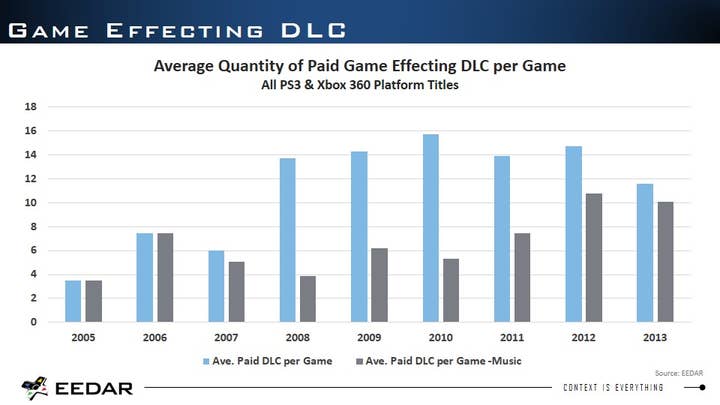Next-gen is "a better marketplace" - EEDAR
EEDAR president Geoffrey Zatkin shares observations on how the new consoles compare to the last generation
In a talk on Wednesday of GDC week at 11:00AM (Room 3007, West Hall), EEDAR president and chief product officer Geoffrey Zatkin will provide an overview of his "Awesome Video Game Data" for 2014. While Zatkin will dive into trends and analysis for every sector of the market from mobile to console, he spoke exclusively with GamesIndustry International in advance to discuss how the new consoles stack up with the launch of the last-gen (PS3, 360, Wii). The takeaway? This new generation of consoles is actually catering to a slightly older audience, and there's more potential to better monetize content than ever before.
Comparing the games released during the first three months of the last generation to this one, it's clear that there are more mature titles in each system's respective portfolio. From PS3 to PS4, the portfolio jumped from around eight percent mature-rated games up to 17 percent; on Xbox One it's up to about 21 percent; even on Wii U mature games are approaching 10 percent.
"E10+ was considered maybe not the kiss of death but only sports games ever got rated E10+. If you look at how it's shifted from PS3 to PS4 they only have half the number of Everyone games launched. E10+ was boosted and a lot of it has come out of teen. They have also doubled the amount of Mature games that have been coming out. We usually don't see such radical shifts. They are redefining who their market is when you look at who they're targeting age wise. They've shifted away in some ways from an audience below 10 fairly dramatically. They are going for an older audience skew on this one," Zatkin commented.

The average age of a gamer has been on the rise, and companies clearly understand that this older audience has more disposable income. Most publishers are doing their best to leverage this fact by targeting players with more and more DLC. Not only that, but the average size of the DLC has been increasing, necessitating an increase in hard drive size. Ultimately, however, Zatkin said that storage is going to become a real problem for many.
"If you went and bought every piece of DLC and averaged them out, in the 7th gen they're basically a tenth of a gig. For 8th gen right now it's basically a seventh of a gig. There's been a huge jump in DLC size, due in a lot of cases to the fidelity you can achieve. And if you look at the hard drive sizes, taking the max size of each one, you can also see there's been a big jump. The average DLC size has gone up 8.8 times the amount and the hard drive sizes have gone up about 12.5 times as much," he noted.
Importantly, it's not just themes or other unessential DLC that's been on the rise. It's game-effecting DLC like new levels, characters, etc. Although there was some artificial inflation in the amount of DLC thanks to the tracks for Guitar Hero and Rock Band, the general trend is definitely still upwards.

"Sure the hard drives are a lot larger, but more and more games are putting more game-effecting DLC that people will buy, so on average over time even with bigger hard drives, because people are downloading more DLC in addition to the games they are downloading, I think we're going to start seeing constraints on the amount people can put on a console unless the [manufacturers] start providing extra storage options," Zatkin said.
"I think the cloud is going to be a really good solution but something to remember is that means you can't do offline play for that," he continued. "We're very bullish on the cloud, but you still have 20 percent of America that has no internet access. That is a percent of the market. It's a tricky thing because everyone wants to be able to give you accessible anywhere and that's a strong value proposition. With the infrastructure in the US there are still limitations on how ubiquitous we can make the technology currently."
Digital marketplaces are growing and the companies will have to solve the storage issue if they want to maintain a robust digital games and DLC economy. "There will need to be an approach to solve this if we want a couple years into this cycle for people to have radical use of the digital marketplace," Zatkin stressed. "It will require additional space on a storage solution somewhere. It could be external hard drives, cloud storage or some combination of those. But we will need something."
As more gamers get comfortable with paid DLC, they've also found themselves paying for more items with in-game currency (Zatkin calls it hard currency). There's been a sizable jump in the number of games that offer purchases with hard currency in this new generation - Forza 5, for example - compared to the last one.
"There were 8400 platform titles [on last gen]. Less than 50 used hard currency in the 7th gen. That's about 0.5 percent. On 8th gen, looking at the launch titles, we can see it's already at 40 percent (PS4) and 45 percent (Xbox One). We can see that there's been a real embracing of some of the new business models on the new gen of consoles with their updated storefronts and bigger hard drives... This is a full adoption of micro-transaction methodology," Zatkin said.
"I think we're going to see everything. I think we'll see premium games, I think we'll see premium games with downloadable content, I think we'll see premium games with downloadable content and micro-transactions, I think we'll see games coming in at lower prices and then offset their lowering in price whether it be to half price or all the way down to free. I think we'll see some really good experimentation and in some cases taking some of the best practices from mobile, social and tablet and moving it into higher-definition games," he continued.

This doesn't mean that every game will be micro-transaction based, as some players will always be willing to pay a premium to get things upfront, Zatkin said.
"As the game audience matures there will always be people with more money than time that don't necessarily want to go download 20 free-to-play games to find the one good one they like. They are going to say 'I have 30,50,60,100 dollars to go spend on a really good entertainment experience. I want the best' - in the same way there will always be teens with no money who are willing to try 30 things to find one they like," he remarked.
What it all adds up to is that industry is continuing to grow and publishers can actually better monetize players if they go about it the right way with the right audience.
"The marketplace has really expanded well; if you make a good enough game you can continue to sell more of your game in a better way than you could on the 7th gen platforms. You can sell better ongoing DLC, you can monetize with micro-transactions, it's a better marketplace. People are more [comfortable with] paying for additional content than they used to be. As practice becomes common practice, and it gets very prevalent, it gives you the ability to monetize well if you execute well. That's a really good thing for the industry," he said.









